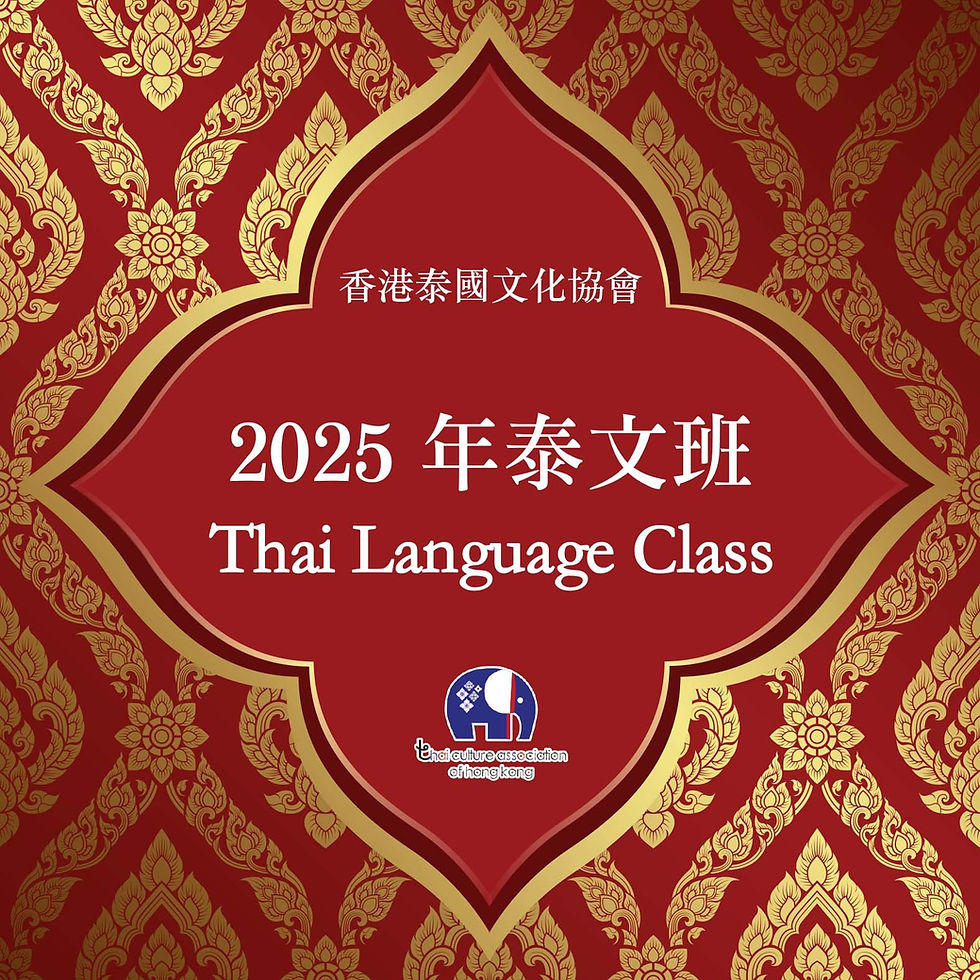潑水節知多點 (1) - The Songkran festival 潑水節
- TCAHK

- Apr 8, 2021
- 4 min read

潑水節知多點 (1) The Songkran festival 潑水節
เทศกาลสงกรานต์ (têet-sà-gaan sŏng-graan) 梵語詞sakrānti,是泰國傳統新年,每年都是4月13日至15日。它與南亞和東南亞許多地方的春節一樣,根據佛教或印度陽曆推算。期間大家用純淨的清水相互潑灑,祈求洗去過去一年不順,新的一年重新出發。
Sanskrit word sakrānti, or literally "astrological passage" is celebrated in Thailand as the traditional New Year's Day from 13 to 15 April. It coincides with the New Year of many calendars of South and Southeast Asia. The festive occasion is in keeping with the Buddhist/Hindu solar calendar. The traditional water pouring is meant as a symbol of washing away all of their sins and bad luck, and it sometimes has fragrant herbs added if celebrated in the traditional manner.
潑水節的起源神話 從前有一個有學習天賦的年輕人,他精通鳥類語言,這引起了其中一個天神Kabil Maha Phrom的嫉妒。於是天神給予年輕人三個謎題,如果年輕人未能在七天之內給予正確的答案,他將失去他的頭;相反,如果他成功了,神會獻上自己的頭顱。
起初年輕人對於三個謎語束手無策,因害怕失敗,但有輕生念頭,但是突然間,年輕人在一棵大樹下停下來,剛好頭上是一個鳥巢。偶然間他聽見鷹媽媽安慰她正在哭嚷更多食物的雛鷹,
他們會因為能品嚐到未能解決謎語的年輕人的身體而感到快慰。
然後,鷹媽媽以天神和年輕人之間打賭的故事,回答雛鷹們的問題,鷹媽媽給他們的答案正解答了那三個謎題,年輕人更在指定日期內天神三個正確答案。
天神因此輸掉了賭注,他自己割掉自己的頭顱。可是,他的頭是一個可怕的頭,如果它接觸到地面,將會有火災發生;如果它墜入海中,海水將因為其酷熱而乾涸。因此,他的頭被存放在天上的一個山洞。
因此,每逢新年,亦即是潑水節那天。因於天神的頭相當有熱力,因此只有天神的七個女兒可以輪流攜帶她們父親的頭,與成千上萬的神和女神像太陽般圍著梅魯山(佛教奧林匹亞山的之一)繞行,儀式後,眾神還會在飲宴中享用從Chamundi(一種鬼神)提煉的果汁作為飲料。天神的頭會在盛宴後帶回洞穴,在翌年的潑水節再次取出。
Myth of the Origins of Songkran There was once a young man who was prodigious in learning. He understood even the language of the birds. This excited the jealousy of Kabil Maha Phrom, one of the gods of a higher heavenly realm. He came down to meet the young man and posed him three sphinx-like riddles with the wager that if the young man failed to give the right answers within seven days, he would lose his head but if he succeeded, the god himself would give his own. Like all folk tales the young man was at first at his wit's end to answer such difficult riddles and he repaired to a certain place in order to kill himself rather than face defeat.
He stopped at the foot of a tall tree at the top of which was a nest. By chance he heard the mother eagle comforting her eaglets who cried for more food, that they would be gratified soon by feasting on the body of the young man who would fail to solve the riddles. She then related the story of the wager between the god and the young man, and in answer to her children's question the mother eagle satisfied them with the right answers to those three riddles. The young man availed himself of this information and on the appointed day he gave the god the three right answers.
The god, as was the case in such tales, lost the wager and himself cut off his own head. His head was a terrible one for if it touched the earth there would be a universal conflagration and if it fell into the sea, the sea would dry up through its intense heat. The god's head therefore was deposited in a certain cave in the heavens. Every new year that is on Songkran Day one of the god's seven daughters in turn will carry her father's head in procession with millions of other gods and goddesses circumambulating like the sun round the Meru, the Buddhist Olympian Mount. After that there are feasts among the celestial beings who enjoyed themselves with drinks made from the juice of the chamunad creeper. The god's head was taken back to the cave after the feast, to be taken out again on Songkran day the next year.



Comments